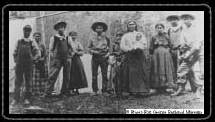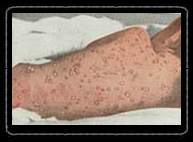Choose your treatment:
|
European |
Lheidli T'enneh |
| Europeans had a vaccine in 1796, which prevented contraction of the disease. If one was unfortunate enough not to have been vaccinated, treatments included rest in a cool, ventilated room, carbolic acid to relieve itching, mercurial face plaster to prevent scarring, castor and cool sponge baths for fever, and saturated solutions of boric acid to prevent swelling. | Natives treated the disease by the use of sweathouses, which killed viral agents if temperatures exceeded 98.6ºF, and also caused increased heart rate, which flushed out impurities as capillaries dilated (Bruchac). Other methods of treatment included the treatment of inflammations with a decoction brewed from young shoots of spruce, or fermentation of red-willow bark, fever is reduced by the use of juniper shoots. Saffron is used as an infusion, it serves to bring out the eruption of measles or chicken pox (Hubbard). |
A bacterial infection of the lungs, tuberculosis causes a patient to have fever, raised pulse, chills, sweat, stomach disturbances and wasting.
Choose your Treatment:
|
European |
Lheidli T'enneh |
|
Europeans had no effective medication for tuberculosis. Rest and fresh air were recommended, as well as a "healthful" diet of milk, raw eggs, raw/rare beef. It was suggested that patients should never "spit on the floor, wall, carpet, stove, or sidewalk" as spit particles could dry up and become air-borne, spreading the disease. |
Native shamans treated tuberculosis as possession by evil spirits. One pioneer recalls a shaman blowing smoke over an infected infant’s face. He passed a rattle over the body, and took it to the window. He then shook the rattle out the window, releasing the spirit. Coughs were treated with brews of black currant, and sweathouses, were also prescribed. |
The world-wide influenza epidemic of 1918 was spread by soldiers coming home from the First World War. An acute case of the flu, symptoms include fever, stuffed nose, sneezing, watering eyes and cough. Depression and delirium also result.
Choose your Treatment:
|
European |
Lheidli T'enneh |
|
European doctors quarantined
the infected in hopes of
isolating the disease.
Mustard plasters from
hip to neck, quinine
and whiskey were
prescribed by Fort George doctors. Some had their own cures, such as
|
Oolichan Oil, which contains vitamins A and D; sweathouses, juniper shoots for fever; and willow bark tea, which contains salicylates (found in Aspirin for pain) were all used by the Natives. |
Some treatments at the time were a little different than what we are used to today. Dr. Lyon once "immunized" a child by sharing cookies with him and his dog. Dr. Lyon would take a bite, the dog would take a bite, and then the boy would take a bite, until they had all had enough cookies. "I'm immunizing this boy. His mother has kept him so damn sterile, he picks up everything that comes along," was his explanation to his astonished nurse, who walked in on the scene.



